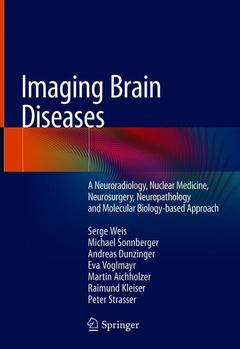Imaging Brain Diseases, 1st ed. 2019 A Neuroradiology, Nuclear Medicine, Neurosurgery, Neuropathology and Molecular Biology-based Approach

This book illustrates in a unique way the most common diseases affecting the human nervous system using different imaging modalities derived from radiology, nuclear medicine, and neuropathology. The features of the diseases are visualized on computerized tomography (CT)-scans, magnetic resonance imaging (MRI)-scans, nuclear medicine scans, surgical intraoperative as well as gross-anatomy and histology preparations. For each disease entity, the structural changes are illustrated in a correlative comparative way based on the various imaging techniques. The brain diseases are presented in a systematic way allowing the reader to easily find the topics in which she or he is particularly interested. In Part 1 of the book, the imaging techniques are described in a practical, straightforward way. The morphological built-up of the normal human brain and its vascular supply are presented in Part 2. The chapters of the subsequent Parts 3 to 10 deal with the following diseases involving the nervous system including: hemodynamic, vascular, infectious, neurodegenerative, demyelination, epilepsy, trauma and intoxication, and tumors.
The authors incite the clinician to see the cell, the tissue, the organ, the disorder by enabling him to recognize brain lesions or interpreting histologic findings and to correlate this knowledge with molecular biologic concepts. Thus, this book bridges the gap between neuro-clinicians, neuro-imagers and neuro-pathologists. The information provided will facilitate the understanding of the disease processes in the daily routine work of neurologists, neuroradiologists, neurosurgeons, neuropathologists, and all allied clinical disciplines.
Prof. Dr. Serge Weis is the head of the Division of Neuropathology at the Neuromed Campus of the Kepler University Hospital, Johannes Kepler University, Linz, Austria. He is a native of Luxembourg, studied medicine at the University of Vienna (Austria). He was trained in neuropathology at the Ludwig-Maximilians University, Munich, Germany. He was deputy director at the Department of Neuropathology, Otto-von Guericke University Magdeburg (Germany) and director of Neuropathology at the Stanley Medical Research Institute, Bethesda, MD, USA. His scientific interests are focused on brain tumors, neurodegeneration and biological psychiatry. He edited the largest book in German-speaking countries on Alzheimer disease and wrote a book, published in 1993, on 3D reconstruction of the brain.
Dr. Michael Sonnberger is a senior consultant in neuroradiology at the Department of Neuroradiology of the Neuromed Campus of the Kepler University Hospital, Johannes Kepler University, Linz, Austria. He studied medicine at the University of Innsbruck (Austria) and was trained in radiology/neuroradiology at the University of Regensburg (Germany) and at the State Neuropsychiatric Hospital Wagner-Jauregg, Linz, Austria. His fields of expertise are interventional neuroradiology and stroke.
Dr. Andreas Dunzinger is a senior consultant in nuclear medicine at the Department of Nuclear Medicine of the Neuromed Campus of the Kepler University Hospital, Johannes Kepler University, Linz, Austria. He studied medicine at the University of Vienna (Austria). He was trained as a general physician at the Hospital of the Sisters of Mercy, Linz, Austria, and in nuclear medicine at the Medical University of Graz and at the State Neuropsychiatric Hospital Wagner-Jauregg, Linz, Austria. His field of expertise is neuro nuclear medicine and neuroendocrinology.
Dr. Eva Voglmayr is a trainee in radiology and neuroradiology at the Department of Neuroradiology of the Neuromed Campus of theKeple
Date de parution : 05-2020
Ouvrage de 2284 p.
17.8x25.4 cm



